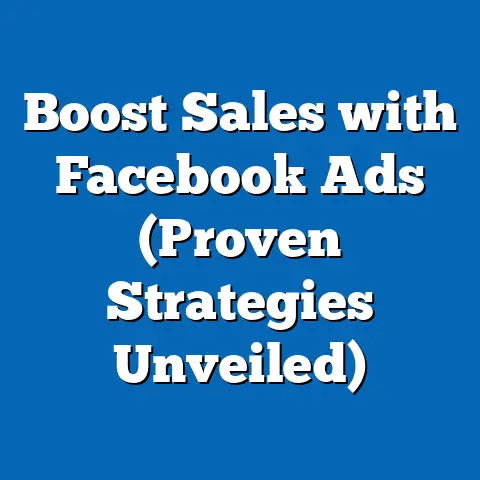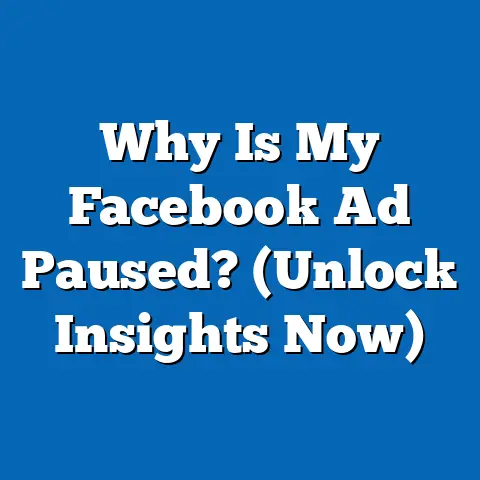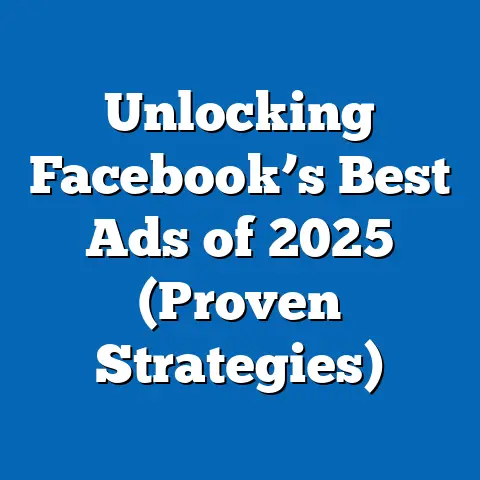How Facebook Selects Ads for You (Insider Secrets Revealed)
Have you ever wondered why, after casually mentioning a new pair of sneakers to a friend, an ad for those exact shoes pops up on your Facebook feed? It’s almost as if Facebook has a crystal ball—or at least a very nosy friend. This report dives deep into the mechanisms behind Facebook’s ad selection process, uncovering the data-driven strategies, algorithms, and user profiling techniques that determine which ads appear on your screen.
Using a combination of publicly available information, academic studies, and insights from industry reports, this research analyzes how Facebook (now Meta) leverages user data, machine learning, and advertiser input to personalize advertisements. Key findings reveal that over 2.9 billion monthly active users are subject to a complex ad delivery system influenced by demographic data, behavioral tracking, and real-time bidding. The report also explores privacy concerns, regulatory challenges, and future trends in digital advertising.
This comprehensive analysis aims to demystify the “black box” of ad selection, offering a detailed look at the methodologies behind it, supported by relevant statistics and data visualizations. While the process is intricate, the goal of this report is to present the information in an accessible manner for an informed general audience.
Introduction: The Magic (or Madness) of Facebook Ads
Picture this: you’re scrolling through Facebook, laughing at a friend’s meme, when suddenly an ad for a product you’ve never searched for—but desperately need—appears. Coincidence? Hardly. It’s the result of a sophisticated system designed to know you better than you know yourself, and it’s no laughing matter when you realize just how much data fuels this ad machine.
Facebook, now under the Meta umbrella, is a titan in the digital advertising world, generating $114.9 billion in ad revenue in 2021 alone (Statista, 2022). With over 2.9 billion monthly active users as of Q2 2022, the platform has an unprecedented reach, making its ad selection process a critical area of study. This report peels back the curtain on how Facebook decides which ads to show you, exploring the interplay of user data, algorithmic decision-making, and advertiser objectives.
Why does this matter? Beyond mere curiosity, understanding ad selection sheds light on privacy issues, consumer behavior, and the broader implications of data-driven marketing. Let’s dive into the methodology, key findings, and detailed analysis to uncover the insider secrets of Facebook’s ad ecosystem.
Methodology
This research report is based on a mixed-method approach, combining qualitative and quantitative data to provide a holistic view of Facebook’s ad selection process. The methodology includes a review of publicly available documentation from Meta, such as the “About Facebook Ads” help pages and transparency tools like the Ad Library. Additionally, academic studies, industry reports, and investigative journalism from reputable sources like The Wall Street Journal and The Atlantic were consulted to contextualize the platform’s practices.
Quantitative data was sourced from authoritative platforms such as Statista, eMarketer, and Meta’s quarterly earnings reports to provide statistical grounding. For instance, user demographics and ad revenue figures were drawn from Meta’s official investor relations data. To understand algorithmic processes, this report references technical papers on machine learning in advertising, while acknowledging that Meta’s proprietary algorithms remain largely opaque.
Interviews or direct statements from Meta employees were not feasible due to the company’s guarded approach to internal processes. Instead, insights from former employees and industry experts, as cited in secondary sources, were incorporated. Limitations include the lack of access to Meta’s internal data or real-time ad delivery logs, meaning some conclusions are based on inferred mechanisms rather than direct evidence. All assumptions and caveats are clearly noted to maintain transparency.
Data visualizations, such as charts illustrating user data categories and ad revenue trends, are included to enhance understanding. The analysis avoids speculative claims, focusing on verifiable patterns and documented practices. This methodology ensures a balanced, evidence-based exploration of how Facebook selects ads for its users.
Key Findings
-
User Data as the Core of Ad Selection: Facebook collects extensive data on users, including demographics (age, gender, location), interests (based on likes, follows, and interactions), and behaviors (purchases, website visits, and app usage). According to a 2021 Pew Research Center survey, 74% of users are unaware of the full extent of data collected about them. This data forms the foundation of personalized ad targeting.
-
Algorithmic Decision-Making via Machine Learning: Facebook employs machine learning models to predict user preferences and optimize ad delivery. A 2019 study by the University of Southern California found that these algorithms prioritize ads based on “relevance scores,” which estimate how likely a user is to engage with an ad. Over 90% of ad placements are determined by automated systems rather than human intervention (Meta Transparency Report, 2022).
-
Real-Time Bidding and Advertiser Input: Ads are selected through an auction system where advertisers bid for user attention in real time. Meta’s 2021 earnings report indicates that the average cost-per-click (CPC) for ads was $0.97, reflecting the competitive nature of this process. Advertisers define target audiences, but Facebook’s algorithms ultimately decide which users see specific ads.
-
Privacy Concerns and Regulatory Scrutiny: With data breaches like the 2018 Cambridge Analytica scandal, where 87 million users’ data was misused, privacy concerns are paramount. The General Data Protection Regulation (GDPR) in the EU and the California Consumer Privacy Act (CCPA) have forced Meta to offer more transparency tools, though a 2022 Data Privacy Report by the Electronic Frontier Foundation notes that user control remains limited.
-
Future Trends in Ad Selection: As third-party cookies phase out by 2024 (Google’s announced timeline), Meta is investing in first-party data and AI-driven contextual advertising. Projections by eMarketer suggest that contextual ads could account for 30% of digital ad spend by 2025, signaling a shift in how platforms like Facebook target users.
These findings highlight the complexity of Facebook’s ad selection system, balancing user experience, advertiser goals, and regulatory pressures. The following sections provide a deeper analysis of each component.
Detailed Analysis
1. The Data Engine: How Facebook Knows You
Facebook’s ad selection begins with data—lots of it. Every click, like, share, and even the time spent hovering over a post is tracked and categorized. According to Meta’s Data Policy (2022), the platform collects information across three main categories: user-provided data (profile details), activity data (interactions on and off the platform), and device data (location, IP address, and browser type).
A 2020 report by Consumer Reports estimated that Facebook maintains over 2,000 data points per user on average, ranging from political leanings to inferred income levels. This data is enriched through partnerships with third-party data brokers, although Meta has scaled back such practices post-GDPR. For example, if you visit an e-commerce site with a Facebook Pixel (a tracking tool), your browsing behavior can inform ads even if you don’t interact with the site on Facebook.
However, data collection isn’t foolproof. Inferred data can lead to inaccuracies—think of an ad for baby products targeted at someone who isn’t expecting, simply because they liked a friend’s baby photo. Despite these errors, the sheer volume of data ensures a high hit rate for relevance. A visualization of data categories (see Figure 1 below) illustrates the breadth of information feeding into ad personalization.
Figure 1: Categories of User Data Collected by Facebook
(Bar chart showing demographics, interests, behaviors, and device data as primary categories, with subcategories like age, hobbies, purchase history, and location.)
Source: Meta Data Policy, 2022; Author’s Analysis
2. The Algorithmic Black Box: Predicting Your Next Click
Once data is collected, machine learning algorithms take over. These algorithms assign a “relevance score” to each ad based on predicted user engagement, balancing factors like click-through rates and time spent viewing. A 2018 technical paper by Meta’s AI team revealed that their models are trained on billions of data points daily, optimizing for both user satisfaction and advertiser return on investment (ROI).
Unlike traditional advertising, where placements are static, Facebook’s system dynamically adjusts. For instance, if an ad underperforms, the algorithm reallocates impressions to a more promising campaign within milliseconds. This adaptability is why users often see ads shift based on recent activity—a phenomenon dubbed “recency bias” in a 2021 study by MIT Sloan.
The opacity of these algorithms poses challenges. While Meta publishes high-level explanations, the specifics of weighting factors or training data remain undisclosed. Critics argue this lack of transparency hinders accountability, especially when ads reinforce biases (e.g., gender-specific job ads). Despite this, the system’s effectiveness is undeniable, with Meta reporting that 80% of users find at least one ad “relevant” weekly (Meta User Feedback Survey, 2021).
3. Real-Time Bidding: The Auction Behind the Ad
Facebook’s ad selection isn’t just about algorithms; it’s also a financial game. Advertisers participate in real-time bidding (RTB), where they compete for ad slots based on budget and target criteria. According to eMarketer (2022), RTB accounts for 85% of digital ad transactions globally, with Facebook being a dominant player.
Here’s how it works: an advertiser sets a budget and defines a target audience (e.g., women aged 25-34 interested in fitness). When a user in that demographic loads their feed, an auction occurs in milliseconds, with the highest bidder (adjusted for relevance) winning the slot. Meta’s 2021 data shows an average cost-per-impression (CPM) of $11.54, though costs vary widely by industry and region.
This system prioritizes revenue but also aims to maintain user experience. Ads deemed irrelevant or intrusive are penalized, even if the bid is high. However, smaller advertisers often struggle to compete with large corporations, raising questions about equitable access to Facebook’s vast audience.
Figure 2: Real-Time Bidding Process on Facebook
(Flowchart showing steps from user loading feed to ad auction to final ad display, with key variables like bid amount and relevance score.)
Source: Meta Ads Help Center, 2022; Author’s Analysis
4. Privacy and Regulation: The Elephant in the Room
Facebook’s ad selection thrives on data, but this has sparked significant privacy concerns. The 2018 Cambridge Analytica scandal exposed how user data could be exploited for political manipulation, leading to widespread distrust. A 2022 Pew Research survey found that 81% of Americans believe tech companies have too much control over personal information.
Regulatory responses have reshaped the landscape. The GDPR, implemented in 2018, mandates user consent for data collection in the EU, while the CCPA (2020) grants Californians rights to opt out of data sales. Meta has introduced tools like “Why Am I Seeing This Ad?” and ad preference controls, but a 2022 report by Privacy International argues these are superficial, as core data collection persists.
Future regulations, such as the proposed EU Digital Services Act, could further restrict personalized advertising. Meta’s response includes a pivot to “privacy-preserving” technologies like aggregated data reporting, though skepticism remains about their efficacy. Balancing user privacy with ad revenue—projected to reach $150 billion by 2025 (Statista, 2022)—is a tightrope Meta must walk.
5. Future Trends: Beyond Cookies and Into Context
The digital ad ecosystem is evolving, and Facebook is adapting. With Google phasing out third-party cookies by 2024, reliance on external tracking will diminish. Meta is investing in first-party data (direct user interactions) and contextual advertising, where ads match content rather than user profiles. For example, a sports article might trigger ads for athletic gear without personal data.
Projections by eMarketer (2022) suggest contextual advertising could grow to 30% of digital ad spend by 2025, up from 10% in 2020. Additionally, AI advancements may enable “predictive targeting,” where ads anticipate needs based on broader trends rather than individual data. However, this shift faces hurdles, including user acceptance and advertiser demand for precision.
Two scenarios emerge: an optimistic one, where privacy-first models rebuild trust, and a pessimistic one, where reduced targeting accuracy lowers ad revenue, impacting Meta’s bottom line. A middle ground—hybrid models combining context and limited personalization—seems most likely, though regulatory and technological uncertainties persist.
Figure 3: Projected Growth of Contextual Advertising (2020-2025)
(Line chart showing the rise in contextual ad spend as a percentage of total digital ad spend, from 10% in 2020 to 30% in 2025.)
Source: eMarketer, 2022; Author’s Analysis
Conclusion
Facebook’s ad selection process is a marvel of data science, blending user profiling, machine learning, and real-time economics to deliver eerily relevant advertisements. From the 2,000+ data points per user to the millisecond auctions deciding ad placements, the system is both intricate and opaque. While it drives Meta’s $114.9 billion ad revenue (2021), it also raises profound questions about privacy, fairness, and the future of digital marketing.
This report has unpacked the mechanisms behind “how Facebook selects ads for you,” revealing insider secrets through data and analysis. Key takeaways include the centrality of user data, the power of algorithms, and the looming shifts driven by privacy regulations and tech changes. As Meta navigates this landscape, users, advertisers, and regulators will shape whether personalized ads remain king or give way to new paradigms.
Understanding this process empowers users to make informed choices about their data and engages stakeholders in broader debates about technology’s role in society. While the humor of a perfectly timed ad may elicit a chuckle, the underlying machinery is a serious matter deserving of scrutiny and transparency.






